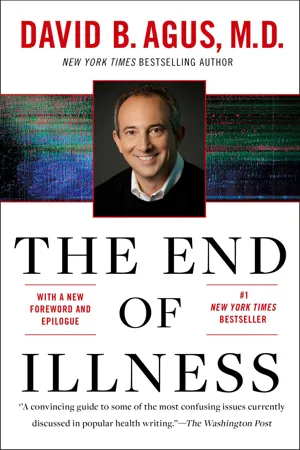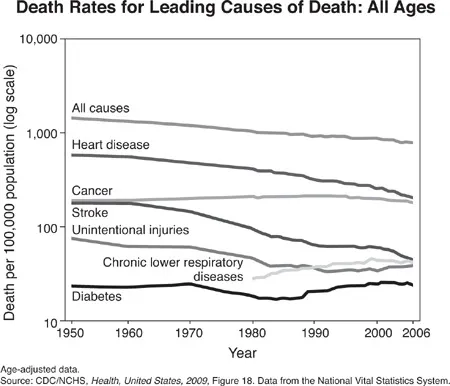![]()
PART I
The Science and Art of Defining Your Health
If I had to sum up this entire book in a single phrase, it would be this: get to know yourself. I don’t mean that in a cosmic or purely psychological way. I’m a big believer in what’s called personalized medicine, which refers to customizing your health care to your specific needs based on your physiology, genetics, value system, and unique conditions. We are finally entering an exciting time in medicine where we have the technology to custom-tailor treatment and preventive protocols just as we’d custom-tailor a suit or designer gown to one’s individual body. But it all begins with you. You have to know yourself in a manner that you’ve probably never done before.
Right now, most of us live by sweeping, general guidelines that are one-size-fits-all. If you want to lose weight, for example, you pick a diet that’s marketed to everyone and which likely recommends that you eat more fibrous vegetables and cut back on processed sugar. If you want to reduce your risk for cancer, you’ll be told to avoid tobacco smoke, to exercise regularly, and to take early detection seriously. But imagine being able to have a more explicit oracle into your future health, as well as a more exacting set of rules to follow today. Think about what it would be like, for instance, to know precisely how to tweak your diet to effortlessly lose twenty pounds for good, or to have a detailed list of things to avoid and things to embrace that make you feel fantastic and be in tip-top shape, or to know what the perfect amount of medicine X is for you to combat affliction Y successfully with no side effects. That’s the promise that personalized medicine has to offer.
But, once again, you won’t be able to enjoy the benefits of personalized medicine until you get up close and personal with yourself. Nothing about health is one-size-fits-all, so until you know how to perform your own “fitting,” you won’t be able to live the long and happy life that’s awaiting you.
The checklist below used to be buried deep in the book somewhere—long after I’d done a lot of explaining and storytelling—but I’ve since plucked it out and placed it here. I want to give you a first step in the right direction before I spend a couple hundred pages fleshing out all of my recommendations in detail. This questionnaire was originally designed to help you prepare for a checkup with your doctor, giving you clues to discuss during your visit. However, while piecing this book together, I realized that the same questionnaire should be filled out before even reading the book, which will help you to know yourself better before embarking on this adventure. I also know that you want to be told what to do as soon as possible, and even though you’ll find lots of “health rules” to consider throughout this book, many of which will be called out at the ends of chapters, at least the following questions will equip you with concepts to think about as you read further and incorporate my advice into your life. This questionnaire is also downloadable online at www.TheEndofIllness.com/questionnaire, where you’ll find a version that you can respond to directly on the page to print for your records and/or take to your doctor.
Unlike other self-tests you find in books and magazines, this one doesn’t have a scorecard at the end. Your answers are your own. Once you’ve incorporated some of my forthcoming suggestions, come back to this questionnaire to check in with yourself whenever you want. See how you change from month to month and year to year. Continue to ask yourself, am I as healthy as I want to be?
Part I is all about defining your health, and I’ll begin by taking you on a tour of how we’ve lost our compass with respect to understanding the human body. I’ll reveal a new perspective that gives us a more accurate compass, and then I’ll help you to use that compass in your journey to optimize your health with the technology we have today. At the end of Part I, I’ll share one of the most powerful medical technologies currently in development that will soon allow each of us to personalize our medicine in a truly sophisticated manner. Knowing about this technology now will give you hope for the future, as well as add context to the information in the rest of the book.
![]()
1
What Is Health?
A New Definition That Changes Everything
Everyone has a vague idea of what it means to live a healthy life. Eating a balanced diet: good. Smoking: bad. Breaking a sweat regularly: good. Binge drinking: bad. Getting a restful night’s sleep: bonus. Being happy: double bonus. Some of us may choose to disregard these basic tenets on occasion, but for the most part, we know the difference between the habits that help us stay youthful and strong, and those that can detract from our well-being.
We try our best to stay out of harm’s way, but what happens when we get sick or develop a chronic medical condition or, heaven forbid, are diagnosed with a serious illness? After experiencing the frustration of Why me? many of us begin to ask ourselves other, more probing inquiries about where we might have gone wrong. Was it something in the water? A lifelong love of hamburgers and fries? An overdemanding boss and, as a result, an overwhelming stress level? Too much alcohol? Too little exercise? Secondhand smoke? Exposure to industrial chemicals? A habit of living dangerously, whatever that might mean? Bad luck?
Or perhaps, some of us think, this outcome was fated because it was just in my DNA all along.
If I could collect a nickel for every time someone in the world thought that genetics was wholly to blame for this illness or that defect, I’d be the wealthiest man on earth. It’s human nature to point fingers at someone or something else for our flaws and shortcomings, and to avoid any personal culpability. Because DNA tends to be a relatively abstract construct, much like black holes or quarks, which we cannot touch, see, or feel, it might as well be a “something else” to which we can assign guilt. After all, DNA is “given” to us by our parents and we have no choice. In this regard, DNA is practically accidental; just as accidents happen, so does DNA, without our having much say in the matter.
What most people don’t think about, though, is that DNA says more about our risk than our fate. It governs probabilities, not necessarily destinies. As my friend and colleague Danny Hillis (whom we’ll meet later when I cover emerging technologies) likes to describe it, DNA is simply a list of parts or ingredients rather than a complete manual that explains how those parts work together to generate results. To hold your DNA responsible for your health is missing the forest for the trees. It’s not the pièce de résistance. I say this knowing full well that DNA does hold certain keys to your health; if it didn’t, then I wouldn’t have cofounded a company that performs genetic testing so you can take preventive measures based on your genomic risk profile. But right from the get-go I want to entice you to start thinking from a broader perspective that goes far beyond your genes. I want you to view your body—from the outer stretches of your skin to the inner sanctum of your cellular makeup—as a whole system. It’s a uniquely organized and highly functioning system that leaves so much to the imagination because we’re only just beginning to solve its riddles.
So therefore, as we probe the mystery of the human body more deeply, we discover that this system, and its complex riddles, don’t necessarily hinge on DNA alone.
The Inescapable Statistics
To understand how we’ve arrived at a place where we focus so much on DNA, and why it’s critical to respect the body as an elaborate system beyond genetics, it helps to explore the evolution of our thinking processes against the backdrop of the challenges we’ve faced—and continue to face—in our quest for health and longevity.
Most of our transformative breakthroughs in medicine have occurred only recently, in the last sixty or so years. Following the discovery of penicillin in 1928, which changed the whole landscape of fighting infections based on the knowledge that they were caused by bacteria, we got good at extending our lives by several years and, in many cases, decades. This was made possible through a constellation of contributing circumstances, including a decline in cigarette smoking, changes in our diets for the better, improvements in diagnostics and medical care, and of course advancements in targeted therapies and drugs such as cholesterol-lowering statins.
Heart disease has been the leading cause of death in the United States since 1921, and stroke has been the third-leading cause since 1938; together, these vascular diseases account for approximately 40 percent of all deaths. Since 1950, however, age-adjusted death rates from cardiovascular disease have declined 60 to 70 percent, representing one of the most important public health achievements of the twentieth century.
Put another way:
But here’s the sobering truth sitting on the sidelines of these triumphs like a lumbering white elephant: the death rate from cancer from 1950 to 2007 (the most current data available from the Centers for Disease Control and Prevention) didn’t change much. We are making enormous progress against other chronic diseases, but little against cancer. Indeed, there are little wins here and there with unique types of cancer. Take, for instance, chronic myelogenous leukemia, a rare type of leukemia that had previously been a death sentence except for a small number of patients who benefited from bone-marrow transplantation. With the FDA approval of Gleevec (brand name for imatinib mesylate) in May 2001—the same month it made the cover of Time magazine as the “magic bullet” to cure cancer—we now have a way to successfully treat most patients and achieve remarkable recovery rates. The drug targets the particular chromosomal rearrangement that is present in this disease (part of chromosome 9 is fused to part of chromosome 22). In clinical trials, the response rate to Gleevec was over 90 percent. People went from their deathbeds to functional life after taking this small molecule with few side effects. But with the more common deadly cancers, including those that ravage...


